Abstract
Third-party logistics (3PL) service providers are crucial to achieving sustainability in supply chain management (SCM). Third-party logistics service providers (3PLSP) are identified in such a way that they can help a firm fulfill its targeted objectives. The choice of 3PLSP must take into account broad selection criteria that are pertinent to both current and future needs. Various modelling techniques have been applied to evaluate and select 3PLSP. For the evaluation and selection of 3PLSP in the given set of situational requirements, a set of different selection criteria has been set up. This paper screens 191 articles from the Scopus database and finds 132 articles spread over two decades from 2001 to 2022 (30 July 2022). The 132 filtered articles are further assessed using bibliometric analysis, qualitatively and quantitatively. The identified research articles are studied and analyzed according to different bibliometric parameters, using MS Excel, VOSviewer version 1.6.17, and Biblioshiny 4.0. It has been found that the top five countries engaged in research are India (36%), Turkey (13%), Taiwan (12%), China (11%), and the USA (10%). The top three journals with the most research publications were International Journal of Logistics Systems and Management, Benchmarking, and Expert Systems with Applications. The three research methodologies most often used to solve 3PL selection problems were fuzzy-based, AHP, and TOPSIS. Numerous studies of theoretical models have applications in real-world situations. The developed selection models have high applicability in the automobile industry, agricultural industries, marine products, etc.
1. Introduction
Third-party logistics (3PL) is growing more and more widespread as a result of globalization, the expansion of E-commerce, and increased client demand. More businesses are attempting to shift away from their accounts to third-party accounts [1]. Stiff competition in the global business world, short lifecycle-based products, and customers’ heightened expectations forced manufacturers to focus on their core competence and shift the other processes to the experts in the markets [2]. To reduce the inventory level in the system, fast and reliable transportation is needed, which may escalate the transportation cost, thus calling for the service of 3PL. Thus, the efficient utilization of 3PL is expected to bring benefits in reducing total costs. The shipper’s need is also satisfied by various contributory sources of 3PL specialization: scale, know-how, searching ability, and IT skills. In addition, it is believed that 3PL may assist shippers in times of business uncertainty [3]. As we move toward Industry 4.0 and prepare for the use of high-tech internet-based tools, such as machine-to-machine communication, deep analytics, cloud computing, the internet of things (IoT), etc., logistics needs and expectations will change. The shipper is expecting Logistics 4.0 to satisfy their customers with high technology-based services such as radio frequency identification (RFID), tracking and tracing devices, a global positioning system (GPS), near-field communication (NFC), etc. Shippers are also interested in using smart containers, smart vehicles, and smart pallets in the highly visible network. As logistics management changes to keep up with Industry 4.0, more technology-based equipment using IoT, big data, and deep learning will support logistics for a giant leap. As logistics management progresses, the idea of Logistics 4.0 will gain popularity. Industry 4.0 will transform corporate business through high-tech digitization. The changes in supply chains (SC), manufacturing systems, production and service realization, E-business models, and E-services to the customer will take place efficiently.
Generally, it is observed that while making logistics selections, most E-retailers believe in selecting a hybrid model of 3PLSP selection and a kind of self-operated logistics in a different product category [4]. A cross-sectional study [5] of Indian shippers concluded that the selection of 3PLSP is made for many significant objectives of the shipper. They are looking to achieve various objectives: “lowering cost”, “focusing on core activities”, “getting customer satisfaction and required service level”, “gaining competitive advantage”, "maintaining quality and reliability of service”, “adopting new technology for combating advantage", "reducing IT based system infrastructure”, “avoiding huge capital expenditure", “making use of state-of-the-art technology”, and “getting flexibility in complying market trends”.
Systematic research led to the design of a labor management system (LMS) for improving the efficiency of working in warehouses. Further, the feasibility of using RFID system deployment in tracking and tracing product movement, pallets, and shipments for lead time reduction was assessed [6]. A UK-based study looked into the skills needed by senior 3PL managers and found that relational and behavioral skills are important for managing well [7].
Competitive pressure has placed an extra burden on firms to implement initiatives for sustainable SCM. Third-party logistics providers use green transportation and timely delivery at the desired location for customer satisfaction, thus employing a sustainable supply chain approach to help the company accomplish sustainability in its SC [8]. The use of ecological, social, and economic criteria must be taken into consideration while selecting a 3PL. This was further demonstrated using data envelopment analysis (DEA) and an analytic network process (ANP) to identify the 3PL from an environmental sustainability perspective [9]. Infrastructure regulations from the government and functional warehouse management may work as enablers to sustainability in SC. A survey of chief executives of 40 large 3PL firms from various regions of North America, Europe, and Asia-Pacific revealed their commitment and strategies toward environmental sustainability [10].
The selection of 3PLSP is carried out after considering several significant criteria. Several factors influence the various criteria used, including product type, strategic partnership requirements, and partnership goals for short- and long-term duration. Based on such requirements, a concept-based framework may be helpful for the selection of 3PLSP [11]. Various criteria are considered for a 3PLSP’s selection: “price of 3PL services”, “quality of tactical logistics services”, “range of available value-added services”, “global capabilities and reach and range of service”,” knowledge and advice on supply chain innovations and improvements”,” availability of strategies logistics services”, “On time shipment and deliveries”, “superior performance rates”,” financial stability of 3PL”, “creative management”, “ability to deliver as promised”, “availability of top management”, “responsiveness to unforeseen occurrences”, “meet performance and quality requirement before price/discussion occurs”, “reputation of vendor”, “willingness to use logistics manpower”, “flexibility in operation and delivery”, “E-commerce capabilities”, and “lead time” [5].
The present research was initiated by looking at the various competitive advantages derivable from 3PLSP and their significant role in various logistics activities. It attempts to answer the following research questions: (i) What are the most important articles demonstrating the selection process of 3PL, who are their authors, and which journals publish such articles? (ii) What are the leading organizations, institutions, and countries contributing to 3PL selection problems? (iii) What are the main 3PL research-oriented clusters across the globe? (iv) How does the 3PL provider support the shipper? (v) What are the reasons why shippers select the 3PLSP option? (vi) What is the future research direction for 3PLSP?
This bibliometric research enables us to understand the 3PLSP-based research at the national and global levels. It also provides an understanding of the 3PLSP selection process based on the local and global selection criteria, and how the selection process is influenced by them. The analysis further helps in gauging the international regulatory response regarding logistics services and future research trends in 3PLSP selection. The paper adds to 3PLSP selection research in the following ways: (i) This study adds to the literature on 3PLSP selection because it lets us look at the performance and scope of 3PLSP selection in logistics management. (ii) The different models that have been suggested from time to time have been looked at more closely, to make it clear which model the company needs to use when getting logistics services. (iii) This research also shows how different industries’ use of different 3PLSP selection models affects their importance and makes the logistics processes better.
The manuscript is further structured in five sections as follows: Section 2 presents a review of literature on 3PLSP selection and related issues. Section 3 provides the research methodology adopted in the present bibliometric analysis and science mapping of published literature. Section 4 offers a discussion of the pertinent research findings, analysis, and implications for the field of study of 3PLSP selection. Section 5 discusses the 3PLSP selection problem using bibliometric analysis. To conclude this research, Section 6 provides conclusions, limitations, and suggestions for future research.
2. Literature Review
3PL may be defined as hiring outside companies to handle all or a portion of the company’s logistics-related tasks, excluding the major core processes of the company [12]. Firms with logistics know-how in coordinating economic resources possess opportunities to provide service and advice to shippers. Such coordinating firms may also be called 3PLSP [3].
Several authors have studied 3PLSP’s criteria and the selection problem of 3PLSP. Several reviews were carried out focusing on the 3PL selection criteria and selection problem, wherein the selection of criteria and methods were studied [13]. The 3PLSP can provide the products in the right quantity, with the right quality, at the right cost, at the right time, and in the right place (4P). When choosing a 3PL, service quality is a crucial consideration. The service quality of 3PLSP were assessed using decision-making based on analytics [14]. A combination of SERVQUAL and the Technique for Order of Preference by Similarity to Ideal Solution (TOPSIS) was combined with the fuzzy analytic hierarchy process (FAHP) to gauge the service quality of 3PLSP [15]. A data mining tool to check the warranty of 3PLSP was used for an electronic facilities company [16]. Various integrated models for the identification of 3PLSP were identified using interpretive structural modelling (ISM) and Matrice d’impacts croisés multiplication appliquée á un classement (MICMAC) analysis [17]. A framework for the sustainability of 3PL was suggested [18]. An empirical study was carried out to find the role of 3PL [19]. Quality function deployment (QFD) under a fuzzy environment was applied in 3PL identification [20]. A combined approach of DEA, TOPSIS, and goal programming (DETOLP) was employed in evaluating 26 vendors for an Indian company for its logistics solution [21]. A survey-based study employed ELECTRE I in assessing 13 3PL who were part of the survey, using four criteria: location, service, information system, and quality [22]. Various fuzzy approaches have also been used in 3PL selection. An appraisal for 3PL was undertaken using interval-valued fuzzy numbers (IVFNs) for an Indian automobile part manufacturing industry [23]; later on, the theory of three parameter interval grey numbers was used in 3PL identification [24].
Various multi-criteria decision-making (MCDM) approaches such as AHP and FAHP were adopted under different scenarios and were carried out for 3PL identification. A logistics performance assessment using FAHP was carried out [25], and AHP was applied in a case study for 3PL [26]. FAHP was used in developing a credit evaluation index system considering “Credit Philosophy”, “Credit ability”, “Credit environment”, and “Credit history” for four 3PLs of Nanjing, China [27]. The fuzzy theory was used to include the perception of the performance measurement team (PMT) in the 3PL evaluation [28]. FAHP with TOPSIS was used in risk assessment for 3PL in Colombia [27]. FAHP in criteria evaluation for 3PL selection was used [29]. FAHP was used in finding 3PL for a cement company in Turkey [30]. The AHP and FAHP approaches were combined to identify the 3PL selection. AHP and graph-theoretic and matrix approaches [31,32,33], two-phase AHP, and TOPSIS along with modified Delphi methods were used in identifying 3PL providers in a Turkish automotive supplier company [34]. A combined approach of FAHP and TOPSIS was used in 3PL identification [35]. FAHP with the balanced scorecard approach was applied in 3PL. The BSC concept was used in forming a hierarchy using financial, customer, internal business process, and learning and growth [36]. FAHP with QFD was applied in 3PL selection by considering the voice of company stakeholders [37]. AHP and the Preference Ranking Organization METHod for Enrichment of Evaluations (PROMETHEE) were used in 3PL [38]. AHP was used in 3PL selection for a company in İstanbul [39]. FAHP and Evaluation Based on Distance from Average Solution (EDAS) were employed in the 3PL evaluation [40]. D number was combined with AHP to form D-AHP, later used in 3PL identification for dairy products produced by the dairy factory in northern Iran [41]. Fuzzy AHP was combined with fuzzy VlseKriterijumska Optimizacija I Kompromisno Resenje (VIKOR) in decision-making for 3PL [42].
3PL identification was carried out using TOPSIS and fuzzy TOPSIS [43]. TOPSIS with interval data was also used to select 3PL [44]. A combined approach of TOPSIS and linear programming was used in identifying the 3PLSP. DEA was used in the vendor’s efficiency evaluation on identified criteria, whereas TOPSIS was employed to rank the efficient vendors, and linear programming was used for quantity allocation to each vendor. AHP and TOPSIS were applied in identifying the 3PL for the biscuit company of Italy [45]. A combined model for 3PL using FAHP and TOPSIS considers supply chain operations as a reference [46,47]. FAHP and FTOPSIS were applied to a confectionary company [48]. For criteria identification and subsequent 3PL identification, FAHP and grey TOPSIS approaches were used [49].
The 3PL selection criteria were studied using a grey decision-making trial and evaluation laboratory (DEMATEL) [50]. FDEMATEL, along with FTOPSIS, was employed for the selection of 3PL [51]. A DEAMTEL with a complex proportional assessment (COPRAS) method was employed for 3PL selection [52]. A combination of DEMATEL, analytic network process (ANP), and DEA was applied for 3PL selection [53]. Third-party logistics also adopts green initiatives to improve green SCM. A WH2 framework in green taxonomy formation and the subsequent development of tools for LSP for accomplishing strategies of environmental-based sustainability was undertaken [54]. Perotti et al. [55] studied the effects of 3PL adopting green initiatives to improve the performance of an Italian company. For 3PLSP, green logistics indicators were researched and evaluated [56]. A type-2 fuzzy TOPSIS was employed in assessing the green 3PLSP [57]. A green 3PL was selected, considering the auction process [58].
A crucial consideration is selecting the best logistics service providers for a cold chain for a firm aiming to establish a cold supply chain that is efficient and sustainable [59]. A cold chain is a supply chain that regulates temperature while handling cold production, storage, and distribution. They are kept in working order by machinery that continuously controls the necessary low-temperature range. A cold chain is used for temperature-sensitive and perishable goods, which has an impact on people’s health and quality of life [60]. Any issues with the cold chain could lead to product deterioration, which could lead to illness, death, or poisoning. A study based on the performance evaluation of five global 3PLSP in cold chain logistics was studied using FAHP and TOPSIS [61]. They recommended that 3PLSP be competitive by including process automation and maintaining innovation in their operations.
AHP and COPRAS were applied considering a grey environment for a cold chain in a case study in Vietnam [59]. Cold chain-related 3PLSP were studied to prevent food losses [62]. An integration of rough step-wise weight assessment ratio analysis (SWARA) and COPRAS was applied for the performance evaluation of 3PL for a company dealing in animal feed in Indonesia [63]. They considered sixteen criteria for the selection of four 3PLSP. Sremac et al. [64] determined eight criteria using rough analysis, and considered 10 3PLSP, evaluating them using a rough weighted aggregated sum product assessment (WASPAS) approach. Furthermore, they carried out sensitivity analysis using rough simple additive weighting (SAW), rough evaluation based on distance from average solution (EDAS), rough multi-attributive border approximation area comparison (MABAC), and rough TOPSIS. Akpinar [65] applied a similar approach and used SWARA and WASPAS for the selection of 12 criteria and five 3PLSP. Prajapati et al. [66] applied the modified SWARA for obtaining the barriers of reverse logistics and employed WASPAS to rank the solution to selected barriers. A combination of three approaches of multi-objective optimization based on ratio analysis (MOORA), SWARA, and WASPAS was used in selecting 3PLSP by considering 10 criteria for the nine reverse logistics service providers [67]. A hybrid approach of fuzzy SWARA-WASPAS was employed in combating the barriers related to logistics solutions to humanitarian SCM by considering 29 barriers and 20 solutions for pre- and post-disaster [68]. A combined approach of grey SWARA and grey combinative distance-based assessment (CODAS) was used in identifying 3PLSP for fabric manufacturing in the Turkish textile industry to resolve global logistics problems [69].
Various activities related to used products, such as transporting them to their manufacturers, storing, and handling such products for refurbishing or recycling, are termed "reverse logistics”. Many researchers studied the reverse logistics operations carried out by 3PLSP. A FAHP approach was used in 3PL in reverse logistics [70]. The DEA methodology was used in 3PL selection for reverse logistics under chance constraints [71]. DEA was also employed in evaluating 3PLSP for a sustainable solution [72]. Multi-criteria decision-making based on a robust design was applied for 3PL selection in reverse logistics [73]. The 3PL barriers in reverse logistics were investigated [74]. Third-party logistics selection through decision-making for sustainability was carried out for 3PLSP for forward and reverse logistics [75].
Bibliometric indicators are being used to evaluate research performance more and more [76]. These indicators, which are based on bibliographic databases, offer helpful data for evaluating the subject area [77]. Exploratory analysis utilizing statistical techniques enables us to examine and meaningfully assess enormous amounts of scientific data for the evaluation of prior research. The bibliometric investigations also provide insights into the subtleties of systematic evolution in a particular topic. It has been observed that different researchers across practically all scientific disciplines are evaluated utilizing the exacting method of bibliometric studies. Therefore, the current bibliometric research needs to look into what has already been done on 3PLSP selection problems.
3. Research Methodology
A methodical strategy must be used to present exploratory research; hence, this study employed the research methodology used by Tranfield [78] so that there is consistency and comprehensiveness in the results obtained. The state-of-the-art reviews focused on a particular domain help perceive the research scenario in that field and identify the future research directions and the prevailing gap in the literature. Bibliometric analysis is recognized as a statistical technique for analyzing and quantifying the expansion of a particular field [79]. The research technique used for data collection and subsequent analysis to accomplish the study’s objectives is shown in Figure 1.
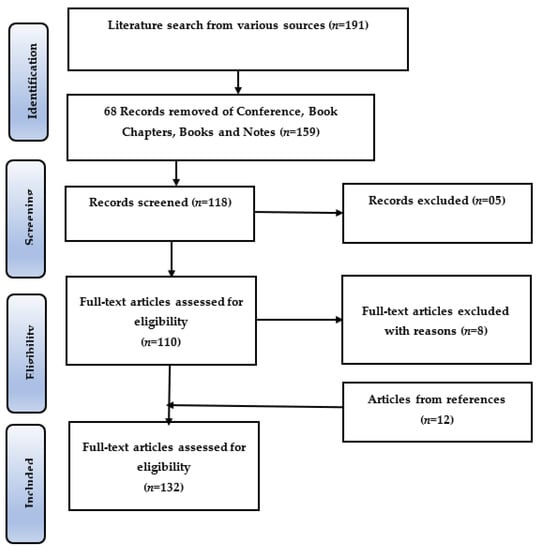
Figure 1.
The article selection methodology on 3PLSP.
The data for 3PLSP in the current bibliometric study was extracted from the Scopus repository. In general, Scopus is regarded as a well-organized database of publications that have undergone peer review, including books, journals, and conference proceedings. It also has a huge database for citations and abstracts. The following categories as shown in Table 1 were taken into consideration when looking for keywords throughout the entire Scopus database on 3PLSP.

Table 1.
Categories for keywords searched in the Scopus database.
A search was conducted for a review of the literature using the Preferred Reporting Items for Systematic Reviews and Meta-Analyses (PRISMA) technique [80]. A search using various keywords was applied to collect the literature. Various filters were used to shortlist the articles for the present problem of 3PL for bibliometric study. The conference articles, book chapters, books, and notes were also excluded as they were considered in excluding criteria using the second filter. In total, 68 articles belonging to excluded criteria were excluded with this filter, and 118 articles were obtained. Each article’s title and abstract were minutely examined, and 8 articles were further eliminated, leaving 110 articles. Using Google Scholar and other references, 12 articles were identified and added to the final tally of searched articles, generating a total of 132 articles.
The Scopus-based dataset provides various items of important information related to authors, article titles, article years, journal names, author affiliations, abstracts, keywords, funding details, names of the publishers, publication type with stages, etc. The Scopus-based dataset was further analyzed using MS Excel. The database was further subjected to VOSviewer version 1.6.17, and Biblioshiny 4.0 for network visualization. One can see and determine connections between publications, authors, organizations, nations, citations, and keywords using bibliometric mapping [81]. A visualization tool for the co-occurrence analysis of keywords analyzed by colors, sizes, and distance is also provided by the VOSviewer software. Biblioshiny also allows comprehensive scientific mapping using an R-tool [82].
4. Results
In this section, the articles from the selected Scopus-based database are distributed and analyzed based on publication year, type, and sources. In addition, contributions from authors, institutes, and countries are presented, respectively.
4.1. Annual Article Publication
Figure 2 displays the number of Scopus papers in the 3PL field. This graph contains years of publication on the x-axis and the number of Scopus publications on the y-axis. The count for publications is presented on top of the annual publication bar.
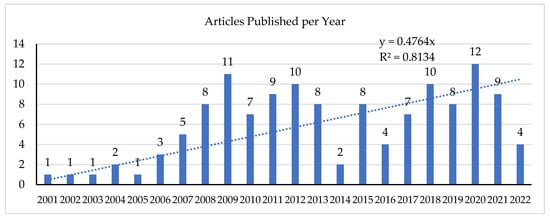
Figure 2.
An annual number of publications (2001–2022 (30 July 2022).
The figure shows a mixed trend of an increase and a decrease in the number of publications. From 2007 to 2012, there has been a gradual increase in average publication counts, which dropped for a year and then increased gradually. When compared to previous years, the number of publications has significantly increased in the year 2020. The number of 3PL articles published in Scopus in 2020 is more than the total publications from 2001 to 2006. The increase in the average number of publications per year indicates the constant interest in 3PL research. The second decade has more than double the number of publications as compared to the first decade of 2001 to 2010. The trendline indicates the rise in the average number of publications with an R2 value of 0.2915, which indicates that the yearly publications are not increasing linearly or exponentially.
Figure 3 presents a forecast model with a confidence level of 80% using the exponential smoothing method. This forecast model has been prepared using Microsoft Excel. Model accuracy measures such as mean absolute scaled error (MASE), symmetrical mean absolute percent error (SMAPE), mean absolute error (MAE), and root-mean-squared error (RMSE) were also calculated. The smoothing coefficients are Alpha (0.13), Beta (0.00), Gamma (0.00), and the error metrics were MASE (1.32), SMAPE (0.37), MAE (2.16), and RMSE (2.77). The forecasting model was prepared for the period 2021-2030. The forecast model indicates the rising interest and opportunity in 3PL research. The accuracy measures may be considered as a forecast accuracy indicator. However, forecast values may change in the future.
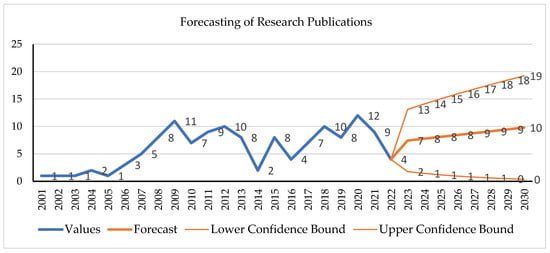
Figure 3.
Forecast model for the number of publications for the decade 2021-2030.
4.2. Publication Types
The Scopus database is categorized into articles, reviews, conference papers, book chapters, books, letters, editorials, short surveys, etc. In the present research, only Scopus articles and reviews were selected, as they may be compared to the systematic literature review (SLR) for the same domain of research. Generally, SLR considers articles and reviews for their analysis and respective findings for future research directions. The present research includes 127 (96.21%) articles and 5 (3.79%) reviews; thus, a total of 132 articles were selected for the bibliometric analysis from 2001 to 2022 (up to 30 July 2022).
4.3. Publication Sources
This section provides details on publication sources for 3PL research indexed in Scopus. Figure 4 indicates that the number of sources publishing articles about 3PL selection varied between two and twelve. The source-wise analysis shows that the journal International Journal of Logistics Systems and Management published 12 articles on 3PL selection, the highest number. The journals Benchmarking and Expert Systems with Applications published seven articles, third most. International Journal of Production Economics published six articles, followed by the journal Sustainability, which published four articles. The journal Computer and Operation Research published three articles. This suggests that there is a high need for 3PL research in the logistics industry.
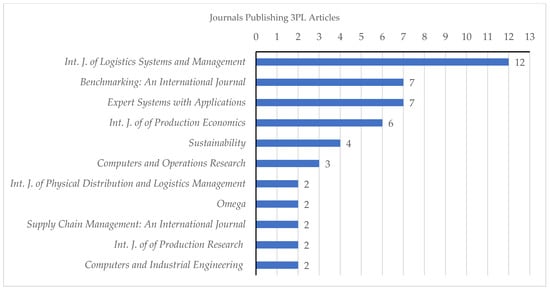
Figure 4.
Leading journals publishing articles on 3PL.
The publication sources also indicate the research was mainly focused on identifying 3PLSP criteria selection, followed by shortlisting criteria, or criteria identification for the selection of 3PLSP. Researchers have applied various modelling approaches. Table 2 lists the top five most productive journals for 3PL.

Table 2.
Top five most productive journals for 3PL.
Cumulative source growth indicates research development in the field of 3PL. Figure 5 shows the cumulative occurrence growth of 15 publication sources with the highest cumulative growth.
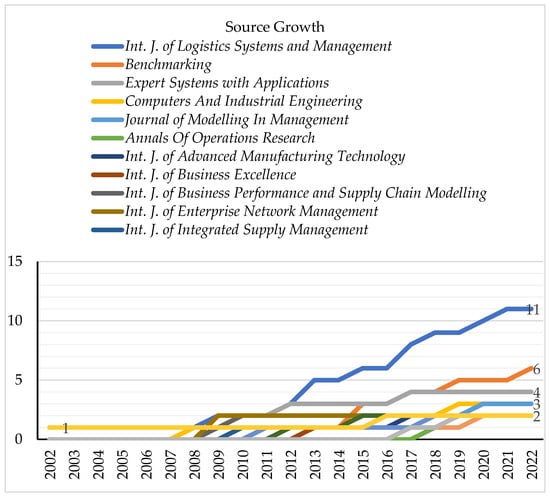
Figure 5.
Source growth.
The Hirsch index, also referred to as the h-index or Hirsch number, is a correlation metric between the citation impact and the productivity of a publication. It can be applied to an individual investigator, department, university, or country [83,84]. Analyzing the publication source based on the h-index provides a better understanding of the impact of the publications. Figure 6 shows publication sources with an h-index.
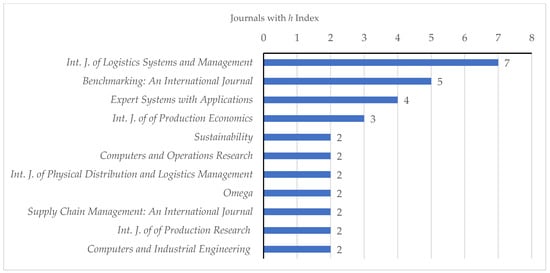
Figure 6.
Publication source with h-index.
4.4. Research Methodologies Used in the 3PL Selection Problem
There have been many research methodologies based on MCDM, fuzzy or grey-based, and combinations of various MCDM approaches have been found to solve the 3PL selection problem. By dividing and considering combinatorial approaches into respective individual approaches, they can be summed up into single categories. Table 3 lists the various research methodologies used in the 3PL selection problem, whereas Figure 7 provides graphical representations of the various research methodologies used to solve the 3PL selection problem.
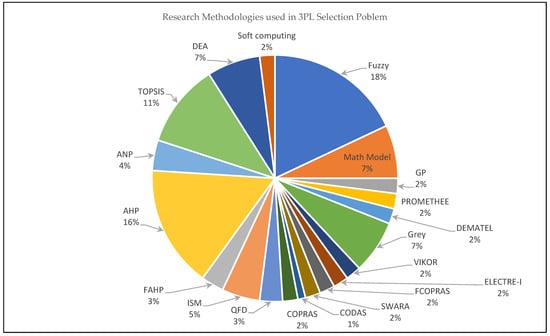
Figure 7.
Research methodologies used in the 3PL selection problem.

Table 3.
Research methodologies used in the 3PL selection problem.
Table 3.
Research methodologies used in the 3PL selection problem.
| Sr. No. | Name of the Research Method | Number of Publications |
|---|---|---|
| 1 | Fuzzy-based | 19 |
| 2 | AHP | 18 |
| 3 | TOPSIS | 12 |
| 4 | Math Model | 7 |
| 5 | DEA | 7 |
| 6 | Grey-based | 7 |
| 7 | ISM | 5 |
| 8 | ANP | 4 |
| 9 | FAHP | 3 |
| 10 | QFD | 3 |
| 11 | Goal Programming | 2 |
| 12 | PROMETHEE | 2 |
| 13 | DEMATEL | 2 |
| 14 | Soft Computing | 2 |
| 15 | ELECTRE-I | 2 |
| 16 | FCOPRAS | 2 |
| 17 | SWARA | 2 |
| 18 | COPRAS | 2 |
| 19 | CODAS | 1 |
| 20 | VIKOR | 1 |
4.5. Countries with 3PL Publications
This section presents countries with the top publications in the area of 3PL. Figure 8 present the analysis of the countries with the leading publications in 3PL. The country with the most publications was India, which, with 36 publications, represents 27.07% of the total articles published. The country with the second-most publications was Turkey, with 10.53% of the total (14 publications), followed by Taiwan, with 9.02% of the total (12 publications), China, with 8.27% of the total (11 publications), the USA, with 7.52% of the total (10 publications), and Iran, with 6.77% of the total (9 publications). The top 10 countries correspond to 56.4% of the total publications, and the rest represent 43.6% of the total publications worldwide concerning 3PLSP selection.
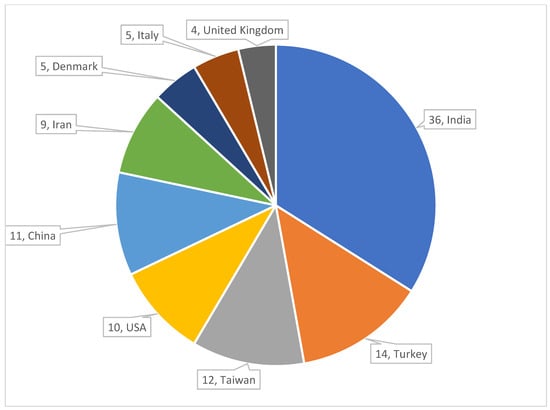
Figure 8.
Leading countries in 3PL publications.
4.6. Leading Organizations and Researchers in 3PL
An analysis of the leading institutes publishing 3PL-related publications and indexed in Scopus from 2001 to 2022 has been presented. The Indian Institute of Technology (India), with nine publications, issued the most. The second most were published by the National Institute of Technology (India), with seven publications, and the third most were published by the Islamic Azad University (Iran), with six publications. The National Institute of Industrial Engineering (NITIE) (India) issued the fourth most, with five publications. The fifth most were published by both Noorul Islam University (India) and the University of Southern Denmark (Denmark). The sixth most publications on the subject, two each, were issued by Cukurova University (Turkey), Galatasaray University (Turkey), Lorraine University (France), and Karadeniz Technical University (Turkey). Figure 9 shows that most publications on 3PL come from the world’s top organizations.
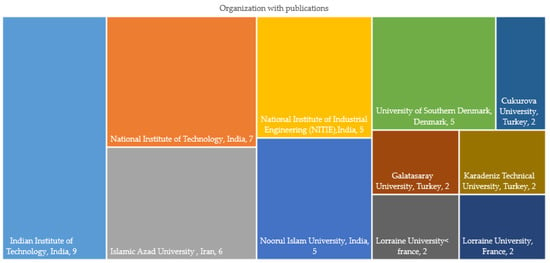
Figure 9.
Organizations leading in 3PL publications.
Figure 10 shows the authors who are leading in the number of publications on 3PL that are indexed in the Scopus database. It is noteworthy that the majority of the top contributors are from India.
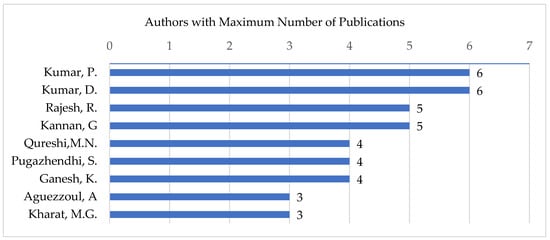
Figure 10.
Authors with the leading number of publications on 3PL.
4.7. Citation Analysis
This section analyses the publications based on citation information in the Scopus database. Table 4 lists the most-cited articles. The publication titled “Selection of logistics service provider: An analytic network process (ANP) approach” was published in Omega, authored by Jharkharia and Shankar [85], and was cited the most frequently, a total of 1013 times. The publication titled “Third-party logistics: A literature review” by Marasco [86] was published in International Journal of Production Economics and received 744 citations, the second most, followed by the publication titled “A hybrid approach using ISM and fuzzy TOPSIS for the selection of reverse logistics provider” by Kannan et al. [87], published in Resources, Conservation and Recycling, which received 730 citations.

Table 4.
List of most-cited articles in the field of 3PL from the Scopus database.
Journals with the highest number of citations of papers published on 3PL indicate the quality of publications that are now being recognized. Table 5 indicates the list of the top ten journals which have received the highest number of citations.

Table 5.
List of top ten journals according to the number of citations received.
The TLS values indicate the inter-citation of the authors in their 3PL publications indexed in Scopus. Table 6 lists the top 10 researchers with the highest citation TLS values. Figure 11 indicates the citation network of authors prepared based on their TLS values.
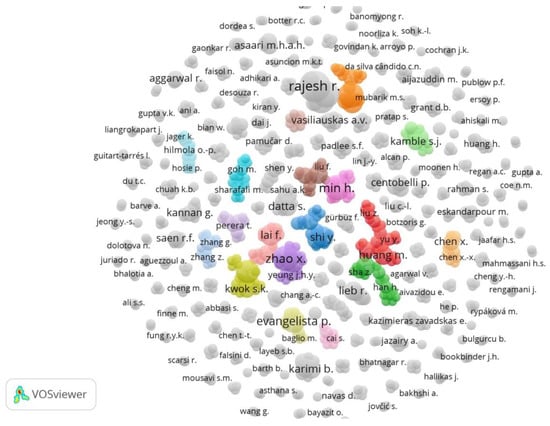
Figure 11.
Citation network of authors with publications in the field of 3PL.

Table 6.
Top ten researchers with the highest total link strength (TLS) values for their citations.
Table 6.
Top ten researchers with the highest total link strength (TLS) values for their citations.
| Rank | Author | Documents | Citations | Total Link Strength (TLS) |
|---|---|---|---|---|
| 1 | Kannan, G. | 6 | 1468 | 10 |
| 2 | Jharkaria, S. | 1 | 1013 | 10 |
| 3 | Marasco, A. | 1 | 744 | 10 |
| 4 | Kumar, P. | 5 | 519 | 9 |
| 5 | Kumar, D. | 6 | 519 | 9 |
| 6 | Qureshi, M.N. | 4 | 506 | 7 |
| 7 | Lai, K.H. | 1 | 473 | 6 |
| 8 | Knemeyer, A.M. | 1 | 312 | 5 |
| 9 | Aguezzoul, A. | 3 | 253 | 4 |
| 10 | Liou, J.J.H. | 1 | 232 | 4 |
4.8. Keyword Analysis
The keywords mentioned in the 3PL articles from the Scopus database have been analyzed. Table 7 presents the top 10 most frequently mentioned keywords in the 3PL articles indexed in the Scopus database. The keywords with the most occurrences were found to be “3PL”, with 121 occurrences, followed by “Third-Party Logistics”, with 119 occurrences.

Table 7.
List of the top 10 keywords and their frequency in the 3PL articles.
This section explains the co-occurrence-based analysis of the technical terms that the 3PL researchers used the most in their Scopus papers. The analytical Scopus viewing barrier was set at 10 instances per keyword. The 10 keywords with the highest total link strength (TLS) values are listed in Table 8, based on co-occurrence linkages with other keywords that exist in 3PL articles. The TLS for the keyword “3PL” is 96, occurring in 122 research articles on 3PL in the Scopus database. It is followed by “Third-Party Logistics” (TLS value 67, occurrence: 120 times) and “Supply Chain Management” (TLS value 65, occurrence: 95 times). Finally, the keyword “outsourcing” has a TLS value of 32 and occurs in 103 articles. The network map of all the terms that co-occurred in Scopus articles between 2001 and 2022 is displayed in Figure 11. To help understand the many networks of the Scopus articles on the subject of 3PL, Figure 12 displays the co-occurrence-based linkages of the keyword “3PL.”

Table 8.
The top 10 keywords with the highest citation TLS values.
The trend shows that there is commendable research work being published. The same can be verified from Figure 11, Figure 12 and Figure 13, in the keyword’s co-occurrence networks. The keyword "3PL" has experienced an increase in occurrences.
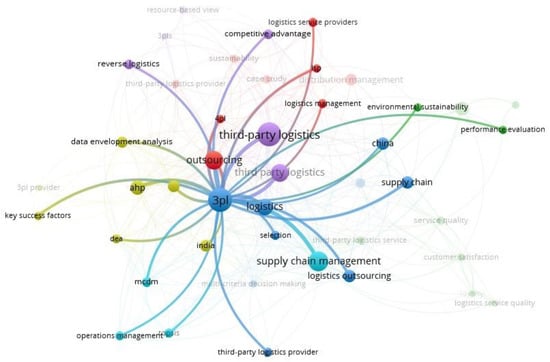
Figure 13.
Keyword 3PL co-occurrence network.
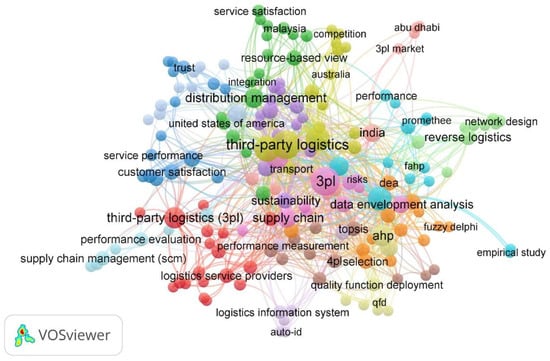
Figure 12.
Keywords co-occurrence network.
The frequency of use of different keywords over the last five years indicates the particular areas in which research is being carried out. Figure 14 shows the growth of different keywords used by authors in 3PL-related articles in the Scopus database from 2001–2021. The keywords “3PL”, “Third-party logistics”, “Supply Chain Management”, and “Outsourcing” have increased since 2015.
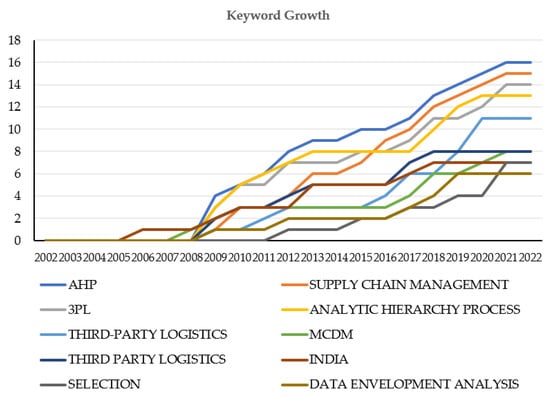
Figure 14.
Growth of keywords in the past two decades.
5. Discussion
The research found on the selection of 3PLSP for a manufacturing company helps a practicing manager to be competitive in the sector by adopting the best logistics services. The 3PLSP help in accomplishing manufacturing companies’ objective of capturing the maximum market share [91]. Evaluation and selection of 3PL is a strategic decision that incorporates several qualitative and quantitative criteria [22]. The bibliometric analysis revealed that reverse logistics constitutes only 10% of the total publications, and forward logistics constitutes 90% of the total publications. Once the raw materials are inducted into the company through the inbound logistics, the production through manufacturing, assembly, and testing operations is set. The realized product initiates the outbound logistics through SC partners, such as dealers and retailers, until it reaches the customer. Forward and backward logistics are both important concerns for manufacturing companies. As we move towards Industry 4.0, logistics will be more challenging because of technological development. It has been seen that the number of articles published in 2020 should grow to 14 in 2025 and 19 in 2030. The 3PSLP research is helping to support the SC, so the increase in the logistics demand will also increase the number of studies each year. The most notable countries, such as India, Turkey, Taiwan, China, the USA, and Iran, are leading in the research. Many interesting selection models are put forward by leading countries. Five reviews on 3PL were conducted to assess the criteria used for 3PL selection and various methods of 3PL selection.
The revolution in internet-based technology has initiated many internet-based technologies, such as the IoT, RFID, cloud computing, big data, Google Earth map, and automation through robots, that have influenced logistics activities.
The evaluation of 3PLSP and its subsequent selection using criteria of service quality [15] and the Kano model [92] have been attempted. The service capability in LSPs from the resource-based view was also examined and further explored to find the differences in service performance in different types of LSPs through an empirical study [90]. Subsequently, they reduced 24 types of logistics services to 13 through exploratory factor analysis and grouped them into three broad categories: value-added logistics services, technology-enabled logistics services, and freight forwarding services. A survey of 665 Danish logistics service providers, including transportation providers, warehousing companies, freight forwarders, and multi-function third-party logistics providers who were using the various modes of air, rail, and truck, found that they offer a wide range of services, but lack in the areas of information systems and supply chain design, which are essential in Industry 4.0 [93].
Several cold chain-related logistics services were also explored by several researchers. The various dimensions of social, economic, and service levels were considered and applied to six cold chain logistics companies in Vietnam using Grey AHP, Grey COPRAS, and Grey TOPSIS to find the potential 3PLSP [59]. The different cold chain stages and the various risk significance levels of each stage were investigated and, subsequently, a combined model with an AHP and failure mode and effect analysis (FMEA) was applied in 3PL selection [94]. Utilizing AHP, the 3PL requirements of a pharmaceutical industry producer were created with the optimization of competing goals, including quality, cost, and delivery time [95].
The 3PL evaluation based on the Kano classification [92] is an important framework to evaluate the service providers. The service part of the 3PL is the essential activity for a shipper; hence, the 3PL evaluation must be carried out on a yearly basis before the renewal of the service contract. The Kano model may be applied to 3PL in various industries, such as medical equipment, automotive, automobile spare parts manufacturing, cement industries, pharmaceutical industries, and dairy product manufacturing industries. Service quality may also be assessed using SERVQUAL [15]. Third-party logistics services may be carried out based on the five dimensions of tangibility, reliability, responsiveness, assurance, and empathy so that stakeholders are satisfied. High customer satisfaction will be able to increase the market share for sustainable supply chain advantages.
6. Conclusions
The paper presents a state-of-art bibliometric analysis of the 132 Scopus articles on 3PLSP research. The Scopus articles were identified from 2001 to 2022 (30 July 2022). The Scopus database index includes 2057 articles for “3PL”, “Outsourcing”, and “Logistics Service providers” keywords. The bibliometric analysis is carried out under three major categories: publication analysis under different heads, citation analysis, and keyword analysis. First, the publication analysis comprises heads such as year of publication, type of publication, sources or organization of publication, and place of researchers. The second category of citation analysis included the most cited articles, most cited articles with 3PL as a word in the title, journals with the highest number of citations for articles on 3PL, researchers with the highest citation TLS values, and the citation network of authors with publication in the field of 3PLSP.
The third category of keyword analysis dealt with frequently used keywords, and keywords with the greatest citation TLS values were classified. The section also dealt with the co-occurrence-based analysis of 3PL-related keywords. The analysis was based on the keywords found in Scopus and used by the researchers in their articles.
The 3PL-related keywords search yielded 191 articles from the Scopus-indexed database. The number of 3PL publications indexed in Scopus has a mixed trend of increasing and decreasing in the number of publications. In 2020, a peak of 12 articles were published. Considering the exponential smoothing method for forecasting, it is expected that by 2030 the annual publication will reach 151. In total, 96.21% (127 articles) of the publications were research articles. Review articles amounted to 3.79% (5 articles) of the total publications.
International Journal of Logistics Systems and Management published 12 articles, followed by 7 articles in Benchmarking, and 6 articles in Expert Systems with Applications. International Journal of Production Economics published six articles, whereas the journal Sustainability published four articles. Expert Systems with Applications has the highest H-score of 225, followed by International Journal of Production Economics, Sustainability, Benchmarking, and International Journal of Logistics Systems and Management with an H-score of 197, 109, 66, and 32, respectively. Indian authors contributed the highest number of Scopus publications in the field of 3PL, 214, followed by India and the USA, with 168 and 101 publications about 3PL, respectively. Kumar, P. and Kumar, D. contributed six articles each, followed by Rajesh, R., who contributed five articles, followed by Kannan, G., Qureshi, M.N., Pugazhendhi, S., and Ganesh, K., who contributed four articles each on 3PL. Three articles were published by Auguezzoul, A. and Kharat, M.G. The Indian Institute of Technology (India) published nine articles, the National Institute of Technology (India) published seven articles, and Islamic Azad University (Iran) published six articles. The articles published in the journal Omega were the most cited (1013 times), followed by the article published in International Journal of Production Economics (cited 744 times), followed by the third-ranked article in Resources, Conservation, and Recycling (cited 730 times). Consequently, the bibliometric analysis in this paper provides extensive information on the different parameters of research related to 3PLSP selection problems published from 2001 to 2022 (30 July 2022). Citation and collaboration among researchers on the 3PLSP selection problem are expected to increase. The leading research came from five countries: India (36%), Turkey (13%), Taiwan (12%), China (11%), and the USA (10%).
The presented bibliometric analysis has some study limitations, which are discussed here. The articles selected are from the Scopus database only, though Scopus provides a significant repository of articles from various authentic journals of reputed publishers. The conference proceedings, books, white papers, and notes contribute scientific knowledge to the body of knowledge as delivered by the journal. The period chosen for the investigation is the second limitation. In a timeline from 2001 to 2022, a total of more than two decades of 3PL selection issues are considered, with 2022 as the dominant, yet unfinished, year.
The present bibliometric analysis and scientific mapping for the 3PL selection problem help in identifying the research gap for future research. There is scant research available on 3PL selection considering service quality in logistics performance based on SEVQUAL [15], SERVPERF, the Kano model [92], and QFD [37,96,97]. The research on 3PL selection for the cold chain [59,60,61] is also struggling to meet the shippers’ needs. Similarly, 3PL for the closed-loop supply chain [98,99] is also scarce. MCDM-based models using VIKOR [42] and ELECTRE I [22,100] may also be applied in 3PL selection for forward and reverse logistics. Most of the articles in the 3PL section are empirical; hence, theory-based research may help shippers to fulfill their needs. Furthermore, a case-based reasoning (CBR) approach may be adopted to solve the 3PL selection problem. The various decision-model or decision-support systems may be further strengthened using artificial intelligence. Various heuristic and metaheuristic-based approaches may be used in solving the 3PL problem. Further research in the area of 3PL service quality may be conducted considering fuzzy environments.
Funding
This research was funded by the Deanship of Scientific Research, King Khalid University, Kingdom of Saudi Arabia, and the grant number is RGP.1/373/43.
Institutional Review Board Statement
Not applicable.
Informed Consent Statement
Not applicable.
Data Availability Statement
Not applicable.
Acknowledgments
We would like to express our gratitude to the Deanship of Scientific Research, King Khalid University, Kingdom of Saudi Arabia, for funding this work, as well as family, friends, and colleagues for their constant inspiration and encouragement.
Conflicts of Interest
The author declares no conflict of interest.
References
- Jovčić, S.; Průša, P. A Hybrid MCDM Approach in Third-Party Logistics (3PL) Provider Selection. Mathematics 2021, 9, 2729. [Google Scholar] [CrossRef]
- Simchi-Levi, D.; Chen, X.; Bramel, J. The Logic of Logistics; Theory, Algorithms, and Applications for Logistic Supply Chain Management; Springer: New York, NY, USA, 2005. [Google Scholar]
- Tezuka, K. Rationale for Utilizing 3PL in Supply Chain Management: A Shippers’ Economic Perspective. IATSS Res. 2011, 35, 24–29. [Google Scholar] [CrossRef][Green Version]
- Shi, Y.; Yang, Z.; Yan, H.; Tian, X. Delivery Efficiency and Supplier Performance Evaluation in China’s E-Retailing Industry. J. Syst. Sci. Complex. 2017, 30, 392–410. [Google Scholar] [CrossRef]
- Samgam, V.; Shee, H.K. Strategic Outsourcing Objectives Drive 3PL Selection Criteria in India. Int. J. Logist. Syst. Manag. 2017, 27, 20–39. [Google Scholar] [CrossRef]
- Tibus, C.A.; Brennan, L.L. RFID and Labor Management Systems Selection in the Logistics Industry. J. Cases Inf. Technol. 2010, 12, 31–49. [Google Scholar] [CrossRef][Green Version]
- Midgley, J.; Bak, O. A Preliminary Investigation into Senior Management Skills: The Context of Third-Party Logistics (3PLs) Providers. Benchmarking Int. J. 2022, 29, 1737–1756. [Google Scholar] [CrossRef]
- Jamali, M.-B.; Rasti-Barzoki, M. A Game Theoretic Approach to Investigate the Effects of Third-Party Logistics in a Sustainable Supply Chain by Reducing Delivery Time and Carbon Emissions. J. Clean. Prod. 2019, 235, 636–652. [Google Scholar] [CrossRef]
- Raut, R.; Kharat, M.; Kamble, S.; Kumar, C.S. Sustainable Evaluation and Selection of Potential Third-Party Logistics (3PL) Providers. Benchmarking Int. J. 2018, 25, 76–97. [Google Scholar] [CrossRef]
- Lieb, K.J.; Lieb, R.C. Environmental Sustainability in the Third-party Logistics (3PL) Industry. Int. J. Phys. Distrib. Logist. Manag. 2010, 40, 524–533. [Google Scholar] [CrossRef]
- Galal, A.; Mostafa, N.; Elawady, H. Supplier Evaluation and Selection for Logistics Outsourcing: A Conceptual Framework. In Proceedings of the International Conference on Industrial Engineering and Operations Management, Washington DC, USA, 27–29 September 2018; pp. 27–29. [Google Scholar]
- Özbek, A.; Tamer, E. Selecting the Third Party Logistic (3PL) Firm through the Analytic Hierarchy Process (AHP). Int. J. Eng. Res. Dev. 2012, 5, 12–20. [Google Scholar]
- Aguezzoul, A. The Third Party Logistics Selection: A Review of Literature. In Proceedings of the International Logistics and Supply Chain Congress, Istanbul, Turkey, 8–9 November 2007; p. 7. [Google Scholar]
- Gupta, A.; Singh, R.K.; Mangla, S.K. Evaluation of Logistics Providers for Sustainable Service Quality: Analytics Based Decision Making Framework. Ann. Oper. Res. 2022, 315, 1617–1664. [Google Scholar] [CrossRef]
- Luyen, L.A.; Van Thanh, N. Logistics Service Provider Evaluation and Selection: Hybrid SERVQUAL–FAHP–TOPSIS Model. Processes 2022, 10, 1024. [Google Scholar] [CrossRef]
- Fazli, S.; Jamaati Tafti, R. Preprocessing Multiple Criteria Decision-Making Using Data Mining (Case Study: Selection of Third Party Logistic in Outsourcing Warranty Services of an Electronic Facilities Company). Mod. Res. Decis. Mak. 2017, 2, 215–239. [Google Scholar]
- Qureshi, M.N.; Kumar, D.; Kumar, P. Modeling the Logistics Outsourcing Relationship Variables to Enhance Shippers’ Productivity and Competitiveness in Logistical Supply Chain. Int. J. Product. Perform. Manag. 2007, 56, 689–714. [Google Scholar] [CrossRef]
- Ali, S.S.; Kaur, R.; Dubey, R. Analysis of 3PL Sustainable Relationship Framework. Int. J. Serv. Oper. Manag. 2014, 17, 404–420. [Google Scholar] [CrossRef]
- Zacharia, Z.G.; Sanders, N.R.; Nix, N.W. The Emerging Role of the Third-Party Logistics Provider (3PL) as an Orchestrator. J. Bus. Logist. 2011, 32, 40–54. [Google Scholar] [CrossRef]
- Qureshi, M.N.; Abdelhadi, A.; Shakoor, M. Developing New Services for 3PL Services Providers Using Fuzzy QFD: A LOGINET Case Study. IUP J. Supply Chain Manag. 2014, 11, 7–38. [Google Scholar]
- Haldar, A.; Qamaruddin, U.; Raut, R.; Kamble, S.; Kharat, M.G.; Kamble, S.J. 3PL Evaluation and Selection Using Integrated Analytical Modeling. J. Model. Manag. 2017, 12, 224–242. [Google Scholar] [CrossRef]
- Aguezzoul, A.; Pires, S. 3PL Performance Evaluation and Selection: A MCDM Method. Supply Chain Forum Int. J. 2016, 17, 87–94. [Google Scholar] [CrossRef]
- Sahu, N.K.; Datta, S.; Mahapatra, S.S. Fuzzy Based Appraisement Module for 3PL Evaluation and Selection. Benchmarking Int. J. 2015, 22, 354–392. [Google Scholar] [CrossRef]
- Sahu, N.K.; Sahu, A.K.; Sahu, A.K. Fuzzy-AHP: A Boon in 3PL Decision Making Process. In Theoretical and Practical Advancements for Fuzzy System Integration; IGI Global: Hershey, PA, USA, 2017; pp. 97–125. [Google Scholar]
- Qureshi, M.N.; Kumar, P.; Kumar, D. Framework for Benchmarking Logistics Performance Using Fuzzy AHP. Int. J. Bus. Perform. Supply Chain Model. 2009, 1, 82. [Google Scholar] [CrossRef]
- Bhatti, R.S.; Kumar, P.; Kumar, D. A Loss Function Based Decision Support Model for 3PL Selection by 4PLs. Int. J. Integr. Supply Manag. 2010, 5, 365–375. [Google Scholar] [CrossRef]
- Osorio, J.C.; Manotas, D.F.; Garc’ia, J.L. Multicriteria 3PL Selection with Risk Considerations. Res. Comput. Sci. 2016, 109, 51–57. [Google Scholar] [CrossRef]
- Bansal, A.; Kumar, P.; Issar, S. Evaluation of a 3PL Company: An Approach of Fuzzy Modelling. Int. J. Adv. Oper. Manag. 2014, 6, 131–161. [Google Scholar] [CrossRef]
- Jovčić, S.; Pruuša, P.; Samson, J.; Lazarević, D. A Fuzzy-AHP Approach to Evaluate the Criteria of Third-Party Logistics (3PL) Service Provider. IJTTE Int. J. Traffic Transp. Eng. 2019, 9, 280–289. [Google Scholar] [CrossRef]
- Bulgurcu, B.; Nakiboglu, G. An Extent Analysis of 3PL Provider Selection Criteria: A Case on Turkey Cement Sector. Cogent Bus. Manag. 2018, 5, 1469183. [Google Scholar] [CrossRef]
- Qureshi, M.N.; Kumar, P.; Kumar, D. Selection of Logistics Services Provider (LSP) under Fuzzy Environment: A Graph-Theoretic and Matrix Approach. Int. J. Logist. Syst. Manag. 2009, 5, 551–573. [Google Scholar] [CrossRef]
- Qureshi, M.N.; Kumar, P.; Kumar, D. Selection of 3PL Service Providers: A Combined Approach of AHP and Graph Theory. Int. J. Serv. Technol. Manag. 2009, 12, 35–60. [Google Scholar] [CrossRef]
- Kasture, S.; Qureshi, M.N.; Kumar, P.; Gupta, I. FAHP Sensitivity Analysis for Selection of Third Party Logistics (3PL) Service Providers. ICFAI J. Supply Chain Manag. 2008, 5, 41–60. [Google Scholar]
- Min, H.; Perçin, S. Evaluation of Third-Party Logistics (3PL) Providers by Using a Two-Phase AHP and TOPSIS Methodology. Benchmarking Int. J. 2009, 16, 588–604. [Google Scholar] [CrossRef]
- Singh, R.; Shankar, R.; Kumar, P.; Singh, R.K. A Fuzzy AHP and TOPSIS Methodology to Evaluate 3PL in a Supply Chain. J. Model. Manag. 2012, 7, 287–303. [Google Scholar] [CrossRef]
- Lin, W.; Hao, Z.; Yu-Rong, Z. Fuzzy Analytic Hierarchy Process (FAHP) and Balanced Scorecard Approach for Evaluating Performance of Third-Party Logistics (TPL) Enterprises in Chinese Context. Afr. J. Bus. Manag. 2012, 6, 521–529. [Google Scholar]
- Ho, W.; He, T.; Lee, C.K.M.; Emrouznejad, A. Strategic Logistics Outsourcing: An Integrated QFD and Fuzzy AHP Approach. Expert Syst. Appl. 2012, 39, 10841–10850. [Google Scholar] [CrossRef]
- Bansal, A.; Kumar, P. 3PL Selection Using Hybrid Model of AHP-PROMETHEE. Int. J. Serv. Oper. Manag. 2013, 14, 373–397. [Google Scholar] [CrossRef]
- Gürcan, Ö.F.; Yazıcı, İ.; Beyca, Ö.F.; Arslan, Ç.Y.; Eldemir, F. Third Party Logistics (3PL) Provider Selection with AHP Application. Procedia—Soc. Behav. Sci. 2016, 235, 226–234. [Google Scholar] [CrossRef]
- Ecer, F. Third-Party Logistics (3PLs) Provider Selection via Fuzzy AHP and EDAS Integrated Model. Technol. Econ. Dev. Econ. 2018, 24, 615–634. [Google Scholar] [CrossRef]
- Dadashpour, I.; Bozorgi-Amiri, A. Evaluation and Ranking of Sustainable Third-Party Logistics Providers Using the D-Analytic Hierarchy Process. Int. J. Eng. 2020, 33, 2233–2244. [Google Scholar]
- Wang, C.-N.; Nguyen, N.-A.-T.; Dang, T.-T.; Lu, C.-M. A Compromised Decision-Making Approach to Third-Party Logistics Selection in Sustainable Supply Chain Using Fuzzy AHP and Fuzzy VIKOR Methods. Mathematics 2021, 9, 886. [Google Scholar] [CrossRef]
- Qureshi, M.N.; Kumar, P.; Kumar, D. 3PL Evaluation and Selection Under a Fuzzy Environment: A Case Study. ICFAI J. Supply Chain Manag. 2008, 5, 38–53. [Google Scholar]
- Qureshi, M.N.; Kumar, D.; Kumar, P. Selection of Potential 3PL Services Providers Using TOPSIS with Interval Data. In Proceedings of the IEEM 2007: 2007 IEEE International Conference on Industrial Engineering and Engineering Management, Singapore, 2–4 December 2007; pp. 1512–1516. [Google Scholar] [CrossRef]
- Bianchini, A. 3PL Provider Selection by AHP and TOPSIS Methodology. Benchmarking Int. J. 2018, 25, 235–252. [Google Scholar] [CrossRef]
- Jothimani, D.; Sarmah, S.P. Supply Chain Performance Measurement for Third Party Logistics. Benchmarking Int. J. 2014, 21, 944–963. [Google Scholar] [CrossRef]
- Qureshi, M.N.; Kumar, D.; Kumar, P. Performance Evaluation of 3PL Services Provider Using AHP and TOPSIS: A Case Study. Icfai J. Supply Chain Manag. 2007, 4, 20–38. [Google Scholar]
- Yayla, A.Y.; Oztekin, A.; Gumus, A.T.; Gunasekaran, A. A Hybrid Data Analytic Methodology for 3PL Transportation Provider Evaluation Using Fuzzy Multi-Criteria Decision Making. Int. J. Prod. Res. 2015, 53, 6097–6113. [Google Scholar] [CrossRef]
- Garside, A.K.; Saputro, T.E. Evaluation and Selection of 3PL Provider Using Fuzzy AHP and Grey TOPSIS in Group Decision Making. AIP Conf. Proc. 2017, 1902, 20056. [Google Scholar]
- Govindan, K.; Khodaverdi, R.; Vafadarnikjoo, A. A Grey DEMATEL Approach to Develop Third-Party Logistics Provider Selection Criteria. Ind. Manag. Data Syst. 2016, 116, 690–722. [Google Scholar] [CrossRef]
- Bali, Ö.; Tutun, S.; Pala, A.; Çörekçi, C. A MCDM Approach with FUZZY DEMATEL and FUZZY TOPSIS for 3PL Provider Selection. Sigma J. Eng. Nat. Sci. 2014, 32, 222–239. [Google Scholar]
- Yuan, Y.; Xu, Z.; Zhang, Y. The DEMATEL—COPRAS Hybrid Method under Probabilistic Linguistic Environment and Its Application in Third Party Logistics Provider Selection. Fuzzy Optim. Decis. Mak. 2022, 21, 137–156. [Google Scholar] [CrossRef]
- Adali, E.; Icsik, A. Integration of DEMATEL, ANP and DEA Methods for Third Party Logistics Providers’ Selection. Manag. Sci. Lett. 2016, 6, 325–340. [Google Scholar] [CrossRef]
- Centobelli, P.; Cerchione, R.; Esposito, E. Environmental Sustainability in the Service Industry of Transportation and Logistics Service Providers: Systematic Literature Review and Research Directions. Transp. Res. Part D Transp. Environ. 2017, 53, 454–470. [Google Scholar] [CrossRef]
- Perotti, S.; Zorzini, M.; Cagno, E.; Micheli, G.J.L. Green Supply Chain Practices and Company Performance: The Case of 3PLs in Italy. Int. J. Phys. Distrib. Logist. Manag. 2012, 42, 640–672. [Google Scholar] [CrossRef]
- Chang, C. Evaluation of Implementing Green Logistics Indicators for Third Party Logistics Providers. Sustainability 2015, 9, 777. [Google Scholar]
- Atasever, C.; Ayvaz, B. Type-2 Fuzzy TOPSIS Model for Green Third Party Logistics Provider Performance Evaluation. Southeast Eur. J. Soft Comput. 2019, 8, 21–30. [Google Scholar] [CrossRef][Green Version]
- Qian, X.; Fang, S.-C.; Yin, M.; Huang, M.; Li, X. Selecting Green Third Party Logistics Providers for a Loss-Averse Fourth Party Logistics Provider in a Multiattribute Reverse Auction. Inf. Sci. 2021, 548, 357–377. [Google Scholar] [CrossRef]
- Nguyen, N.-A.-T.; Wang, C.-N.; Dang, L.-T.-H.; Dang, L.-T.-T.; Dang, T.-T. Selection of Cold Chain Logistics Service Providers Based on a Grey AHP and Grey COPRAS Framework: A Case Study in Vietnam. Axioms 2022, 11, 154. [Google Scholar] [CrossRef]
- Dagsuyu, C.; Derse, O.; Oturakci, M. Integrated Risk Prioritization and Action Selection for Cold Chain. Environ. Sci. Pollut. Res. 2021, 28, 15646–15658. [Google Scholar] [CrossRef]
- Singh, R.K.; Gunasekaran, A.; Kumar, P. Third Party Logistics (3PL) Selection for Cold Chain Management: A Fuzzy AHP and Fuzzy TOPSIS Approach. Ann. Oper. Res. 2018, 267, 531–553. [Google Scholar] [CrossRef]
- Raut, R.D.; Gardas, B.B.; Narwane, V.S.; Narkhede, B.E. Improvement in the Food Losses in Fruits and Vegetable Supply Chain-a Perspective of Cold Third-Party Logistics Approach. Oper. Res. Perspect. 2019, 6, 100117. [Google Scholar] [CrossRef]
- Rosiana, E.; Garside, A.K.; Amallynda, I. Integration of Rough SWARA and COPRAS in the Performance Evaluation of Third-Party Logistics Providers. J. Tek. Ind. 2021, 22, 31–42. [Google Scholar] [CrossRef]
- Sremac, S.; Stević, Ž.; Pamučar, D.; Arsić, M.; Matić, B. Evaluation of a Third-Party Logistics (3PL) Provider Using a Rough SWARA--WASPAS Model Based on a New Rough Dombi Aggregator. Symmetry 2018, 10, 305. [Google Scholar] [CrossRef]
- Akpinar, M.E. Third-Party Logistics (3PL) Provider Selection Using Hybrid Model of SWARA and WASPAS. Int. J. Pure Appl. Sci. 2021, 7, 371–382. [Google Scholar] [CrossRef]
- Prajapati, H.; Kant, R.; Shankar, R. Prioritizing the Solutions of Reverse Logistics Implementation to Mitigate Its Barriers: A Hybrid Modified SWARA and WASPAS Approach. J. Clean. Prod. 2019, 240, 118219. [Google Scholar] [CrossRef]
- Jayant, A.; Singh, S.; Garg, S.K. An Integrated Approach with MOORA, SWARA, and WASPAS Methods for Selection of 3PLSP. In Proceedings of the International Conference on Industrial Engineering and Operations Management, Paris, France, 26–27 July 2018; Volume 2018, pp. 2497–2509. [Google Scholar]
- Agarwal, S.; Kant, R.; Shankar, R. Evaluating Solutions to Overcome Humanitarian Supply Chain Management Barriers: A Hybrid Fuzzy SWARA--Fuzzy WASPAS Approach. Int. J. Disaster Risk Reduct. 2020, 51, 101838. [Google Scholar] [CrossRef]
- Ulutaş, A. A Grey Hybrid Model to Select the Optimal Third-Party Logistics Provider. South African J. Ind. Eng. 2021, 32, 171–181. [Google Scholar] [CrossRef]
- Zhang, Y.; Feng, Y. A Selection Approach of Reverse Logistics Provider Based on Fuzzy AHP. In Proceedings of the Fourth International Conference on Fuzzy Systems and Knowledge Discovery (FSKD 2007), Haikou, China, 24–27 August 2007; Volume 3, pp. 479–482. [Google Scholar]
- Azadi, M.; Saen, R.F. A New Chance-Constrained Data Envelopment Analysis for Selecting Third-Party Reverse Logistics Providers in the Existence of Dual-Role Factors. Expert Syst. Appl. 2011, 38, 12231–12236. [Google Scholar] [CrossRef]
- Choudhury, N.; Raut, R.D.; Gardas, B.B.; Kharat, M.G.; Ichake, S. Evaluation and Selection of Third Party Logistics Services Providers Using Data Envelopment Analysis: A Sustainable Approach. Int. J. Bus. Excell. 2018, 14, 427–453. [Google Scholar] [CrossRef]
- Senthil, S.; Srirangacharyulu, B.; Ramesh, A. A Robust Hybrid Multi-Criteria Decision Making Methodology for Contractor Evaluation and Selection in Third-Party Reverse Logistics. Expert Syst. Appl. 2014, 41, 50–58. [Google Scholar] [CrossRef]
- Sirisawat, P.; Kiatcharoenpol, T. Fuzzy AHP-TOPSIS Approaches to Prioritizing Solutions for Reverse Logistics Barriers. Comput. Ind. Eng. 2018, 117, 303–318. [Google Scholar] [CrossRef]
- Govindan, K.; Agarwal, V.; Darbari, J.D.; Jha, P.C. An Integrated Decision Making Model for the Selection of Sustainable Forward and Reverse Logistic Providers. Ann. Oper. Res. 2019, 273, 607–650. [Google Scholar] [CrossRef]
- Wallin, J.A. Bibliometric Methods: Pitfalls and Possibilities. Basic Clin. Pharmacol. Toxicol. 2005, 97, 261–275. [Google Scholar] [CrossRef] [PubMed]
- Hood, W.W.; Wilson, C.S. Informetric Studies Using Databases: Opportunities and Challenges. Scientometrics 2003, 58, 587–608. [Google Scholar] [CrossRef]
- Tranfield, D.; Denyer, D.; Smart, P. Towards a Methodology for Developing Evidence-Informed Management Knowledge by Means of Systematic Review. Br. J. Manag. 2003, 14, 207–222. [Google Scholar] [CrossRef]
- Tao, J.; Qiu, D.; Yang, F.; Duan, Z. A Bibliometric Analysis of Human Reliability Research. J. Clean. Prod. 2020, 260, 121041. [Google Scholar] [CrossRef]
- Khan, A.A.; Parikh, H.; Qureshi, M.R.N. A Review on Chicken Feather Fiber (CFF) and Its Application in Composites. J. Nat. Fibers 2022, 1–21. [Google Scholar] [CrossRef]
- van Eck, N.J.; Waltman, L. Software Survey: VOSviewer, a Computer Program for Bibliometric Mapping. Scientometrics 2010, 84, 523–538. [Google Scholar] [CrossRef] [PubMed]
- Ahmi, A. Bibliometric Analysis Using R for Non-Coders: A Practical Handbook in Conducting Bibliometric Analysis Studies Using Biblioshiny for Bibliometrix R Package. 2022. Available online: https://books.google.com.hk/books?id=kPhiEAAAQBAJ&printsec=frontcover#v=onepage&q&f=false (accessed on 14 August 2022).
- Hirsch, J.E. An Index to Quantify an Individual’s Scientific Research Output. Proc. Natl. Acad. Sci. USA 2005, 102, 16569–16572. [Google Scholar] [CrossRef] [PubMed]
- McDonald, K. Physicist Proposes New Way to Rank Scientific Output. PhysOrg, 8 November 2005; 1–3. [Google Scholar]
- Jharkharia, S.; Shankar, R. Selection of Logistics Service Provider: An Analytic Network Process (ANP) Approach. Omega 2007, 35, 274–289. [Google Scholar] [CrossRef]
- Marasco, A. Third-Party Logistics: A Literature Review. Int. J. Prod. Econ. 2008, 113, 127–147. [Google Scholar] [CrossRef]
- Kannan, G.; Pokharel, S.; Sasi Kumar, P. A Hybrid Approach Using ISM and Fuzzy TOPSIS for the Selection of Reverse Logistics Provider. Resour. Conserv. Recycl. 2009, 54, 28–36. [Google Scholar] [CrossRef]
- Büyüközkan, G.; Feyzioğlu, O.; Nebol, E. Selection of the Strategic Alliance Partner in Logistics Value Chain. Int. J. Prod. Econ. 2008, 113, 148–158. [Google Scholar] [CrossRef]
- Govindan, K.; Palaniappan, M.; Zhu, Q.; Kannan, D. Analysis of Third Party Reverse Logistics Provider Using Interpretive Structural Modeling. Int. J. Prod. Econ. 2012, 140, 204–211. [Google Scholar] [CrossRef]
- Lai, K. Service Capability and Performance of Logistics Service Providers. Transp. Res. Part E Logist. Transp. Rev. 2004, 40, 385–399. [Google Scholar] [CrossRef]
- Qureshi, M.N.; Kumar, D.; Kumar, P. An Integrated Model to Identify and Classify the Key Criteria and Their Role in the Assessment of 3PL Services Providers. Asia Pacific J. Mark. Logist. 2008, 20, 227–249. [Google Scholar] [CrossRef]
- Asian, S.; Pool, J.K.; Nazarpour, A.; Tabaeeian, R.A. On the Importance of Service Performance and Customer Satisfaction in Third-Party Logistics Selection. Benchmarking Int. J. 2019, 26, 1550–1564. [Google Scholar] [CrossRef]
- Larson, P.D.; Gammelgaard, B. Logistics in Denmark: A Survey of the Industry. Int. J. Logist. Res. Appl. 2001, 4, 191–206. [Google Scholar] [CrossRef]
- Salas-Navarro, K.; Serrano-Pájaro, P.; Ospina-Mateus, H.; Zamora-Musa, R. Inventory Models in a Sustainable Supply Chain: A Bibliometric Analysis. Sustainability 2022, 14, 6003. [Google Scholar] [CrossRef]
- Bamatov, I.M.; Utyuzh, A.S.; Sekerin, V.D.; Gorokhova, A.E.; Shevchenko, D.A.; Gayduk, N.V. Selecting a Provider as the Most Important Step in Building a Cold Chain in Pharmaceutical Logistics. Res. J. Pharm. Technol. 2020, 13, 4641. [Google Scholar] [CrossRef]
- Perçin, S.; Min, H. A Hybrid Quality Function Deployment and Fuzzy Decision-Making Methodology for the Optimal Selection of Third-Party Logistics Service Providers. Int. J. Logist. Res. Appl. 2013, 16, 380–397. [Google Scholar] [CrossRef]
- Ho, W.; Bennett, D.J.; Mak, K.L.; Chuah, K.B.; Lee, C.K.M.; Hall, M.J. Strategic Logistics Outsourcing: An Integrated QFD and AHP Approach. In Proceedings of the 2009 IEEE International Conference on Industrial Engineering and Engineering Management, Hong Kong, China, 8–11 December 2009; pp. 1434–1438. [Google Scholar]
- Sasikumar, P.; Haq, A.N. Integration of Closed Loop Distribution Supply Chain Network and 3PRLP Selection for the Case of Battery Recycling. Int. J. Prod. Res. 2011, 49, 3363–3385. [Google Scholar] [CrossRef]
- Ghoushchi, S.J.; Hushyar, I. Designing a Closed-Loop Supply Chain Network and Providing a Multi-Objective Mathematical Model to Select a Third-Party Logistics Company and Supplier Simultaneously. Int. J. Ind. Eng. 2020, 27, 245–275. [Google Scholar]
- Govindan, K.; Kadziński, M.; Ehling, R.; Miebs, G. Selection of a Sustainable Third-Party Reverse Logistics Provider Based on the Robustness Analysis of an Outranking Graph Kernel Conducted with ELECTRE I and SMAA. Omega 2019, 85, 1–15. [Google Scholar] [CrossRef]
Publisher’s Note: MDPI stays neutral with regard to jurisdictional claims in published maps and institutional affiliations. |
© 2022 by the author. Licensee MDPI, Basel, Switzerland. This article is an open access article distributed under the terms and conditions of the Creative Commons Attribution (CC BY) license (https://creativecommons.org/licenses/by/4.0/).